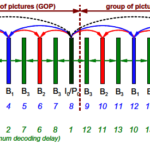Pls. bear in mind that the frame_num parameter in the slice header of AVC/H.264 picture is not actually the frame counter since frame_num is not incremented after a non-reference frame. So, if all frames in a video sequence are ued for reference then frame_num = frame counter.
For example in the following cadence (in encoding order)where subscript indexes denotes frame_num values and superscript indexes denotes POC, capital letter corresponds to frames used for reference:
I00 P61 b22 b42 P82 P103 (A)
Here b22 b42 is a pair of B frames not used for reference.
- Benefit 1 [ Successive B-frames swapping]:
In the context of the above sequence (A) let’s suppose that for keeping of HRD compliancy it’s worth to swap b22 and b42 (e.g. if b22 is much greater than average B-frame size and CPB buffer violation estimated). Because frame_num values of the two successive B frames are equal and the two frames are independent each another, hence the swap does not violate decoding process but might prevent HRD or T-STD violations in some situations. So, an encoder can transmit the above cadence (A) in a slightly different order:
I00 P61 b42 b22 P82 P103
If frame_num had been incremented as frame counter we could not swap non-reference B-frames.
- Benefit 2 [ Stream thinning – removal of non-reference B-frames]:
Sometimes due to bandwidth problem a server can decide to thin transmitted stream by removal non-reference B-frames. Because a non-reference frame is not used for reference of next pictures, its removal does not impact on next pictures. Therefore removal of non-reference B-frames inevitable reduces the overall bitrate (although a jitter can be observed). Moreover, because frame_num is not incremented on non-reference frames, gaps in frame_num are avoided.
If frame_num had been incremented as frame counter we could not remove non-reference frames without producing gaps in frame_num cadence.
- Benefit 3 [ Frame Rate Correction – duplication of frames]:
Sometimes a frame rate correction is required from lower frame rate to higher one (e.g. from 30 fps to 60fps), in such case some frames should be duplicated.
Example: For the sake of simplicity let’s suppose that an IP-only (i.e. IPPPPP…) stream is given and it’s required to ‘upscale’ the frame rate from 29.97 fps to 30 fps. We can perform this task without re-encoding, by insertion of a non-reference P-skip frame each 300 frames. Notice that P-skip frame is a P-frame where all MBs are skipped (with zero motion vector). Because P-skip frame is not used for reference its frame_num is not incremented and no gap in frame_num cadence created.
23+ years’ programming and theoretical experience in the computer science fields such as video compression, media streaming and artificial intelligence (co-author of several papers and patents).
the author is looking for new job, my resume






I like the efforts you have put in this, thanks for all the great posts.
As I website possessor I believe the content material here is rattling excellent , appreciate it for your hard work. You should keep it up forever! Good Luck.
I’m still learning from you, as I’m trying to achieve my goals. I absolutely love reading everything that is posted on your blog.Keep the information coming. I loved it!
An impressive share, I just given this onto a colleague who was doing a little analysis on this. And he in fact bought me breakfast because I found it for him.. smile. So let me reword that: Thnx for the treat! But yeah Thnkx for spending the time to discuss this, I feel strongly about it and love reading more on this topic. If possible, as you become expertise, would you mind updating your blog with more details? It is highly helpful for me. Big thumb up for this blog post!
As I website possessor I believe the content material here is rattling wonderful , appreciate it for your hard work. You should keep it up forever! Best of luck.
Enjoyed examining this, very good stuff, regards. “It requires more courage to suffer than to die.” by Napoleon Bonaparte.
Great site. Plenty of helpful info here. I’m sending it to a few friends ans also sharing in delicious. And naturally, thanks on your effort!
I appreciate, cause I found exactly what I was looking for. You have ended my four day long hunt! God Bless you man. Have a great day. Bye
Great amazing things here. I?¦m very happy to peer your post. Thanks so much and i am looking ahead to contact you. Will you please drop me a e-mail?
slavah264@gmail.com
You have remarked very interesting details ! ps nice web site.
Some genuinely interesting info , well written and broadly speaking user friendly.